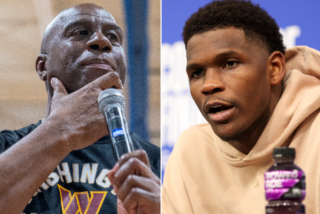Health Fair Has Words to Live By
- Share via
John Hall didn’t come looking for the fountain of youth Sunday. The 83-year-old, who has been plagued with eye problems and bronchitis, just wanted to find out what he could do to stop what he calls “the decline.”
“My health is going downhill. I have no question about that,” said the Covina resident. “I’m not going to live to 150, but I just want to see what I could do to improve my quality of life.”
Hall was not alone. An audience of 50, mostly elderly, turned up at a workshop titled “How to Find a Good Alternative Medical Practitioner,” one of many sessions on the final day of the Los Angeles Times Festival of Health at USC.
The workshop panelists consisted of four alternative medical practitioners who explained the benefits and misperceptions of alternative approaches, such as herbal remedies and acupuncture. They also urged attendees to view alternative practices as complementary to traditional Western medicine.
Kevin McNamee, an acupuncturist and chiropractor, said the term “alternative medicine” is a misnomer.
“We’re becoming the traditional healer. We’re becoming the convention,” said McNamee. He told the audience to ask specific questions about the extent of a practitioner’s training and experience before seeking treatment.
The festival’s biggest draw seemed to be former Los Angeles Laker superstar Earvin “Magic” Johnson, who was diagnosed as having HIV in 1991.
He spoke about the critical need for preventive care, particularly in minority communities.
“As minorities, we have to take care of ourselves a lot better,” Johnson said, referring to statistics indicating blacks are dying from AIDS and breast cancer at disproportionate rates.
“We have to get the information out. . . . Tell your friends to get check-ups; please do that,” he urged.
The diverse crowd of 500 seemed to get the message, but some wished more young people had been present to hear it.
“I was impressed that he targeted minorities,” said Gary Ramirez, a 23-year-old USC student majoring in health promotion and disease prevention. “But there aren’t that many young minorities here.”
But for some, Johnson’s remarks proved what health prevention specialists have known for years: Prevention messages are most effective when communicated by someone the target audience can identify with.
Jermell Brooks, an 18-year-old student at El Camino College who enjoys playing basketball, was listening.
“He has the virus. He knows what he’s talking about,” said Brooks.
Half an hour later, actor and activist Edward James Olmos took the stage, where he urged the audience to think of violence as a health issue.
“We should vaccinate against violence,” he said. “Violence is a health problem, not a judicial problem.” Olmos, 52, was on hand to promote a violence prevention video titled “It Ain’t Love.”
More to Read
Go beyond the scoreboard
Get the latest on L.A.'s teams in the daily Sports Report newsletter.
You may occasionally receive promotional content from the Los Angeles Times.










